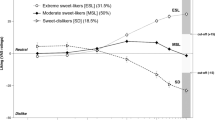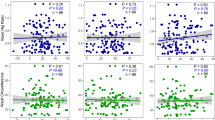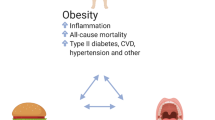Abstract
Background/objectives:
As taste preferences may be associated with obesity, the present study investigated whether obese subjects presented heightened liking for the sensations of sweet, salt and fat.
Subjects/Methods:
Liking scores were determined by a questionnaire including 83 items on liking for sweet or fatty foods, and the preferred extent of seasoning with salt, sweet or fat. Data from 46 909 adults included in the French web-based observational cohort of the Nutrinet-Santé study were collected and weighted according to the national population census. Relationships between liking scores and body mass index (BMI) as categorical or linear explanatory variable were assessed separately by gender using covariance and linear regression analyses, adjusted for age, education level, living area, smoking and alcohol.
Results:
Overall liking scores for salt and fat were linearly positively linked to BMI in men and women (P⩽0.001) and were higher in obese than in normal-weight individuals. The score difference between BMI categories was greater in women for fat liking only. For sweet liking, results differed between gender and compounding factors. Liking for added sugar and sweet foods was positively linked to BMI in women unlike in men; liking for natural sweetness was negatively linked to BMI in both genders.
Conclusions:
This study demonstrates that the relationship between liking and BMI differs according to the gender in its magnitude for fat and in its nature for sweet, unlike that for salt. Liking for sweet and fat may be linked to overconsumption of the corresponding foods, especially in women. This warrants further investigation.
This is a preview of subscription content, access via your institution
Access options
Subscribe to this journal
Receive 12 print issues and online access
$259.00 per year
only $21.58 per issue
Buy this article
- Purchase on Springer Link
- Instant access to full article PDF
Prices may be subject to local taxes which are calculated during checkout
Similar content being viewed by others
References
American Institute for Cancer Research/World Cancer Research Fund. Food, Nutrition, Physical Activity and the Prevention of Cancer: A Global Perspective. American Institute for Cancer Research/World Cancer Research Fund: Washington, DC, 2007.
Hercberg S, Chat-Yung S, Chauliac M The French National Nutrition and Health Program: 2001-2006-2010. Int J Public Health 2008; 53: 68–77.
Blundell JE, Finlayson G Is susceptibility to weight gain characterized by homeostatic or hedonic risk factors for overconsumption? Physiol Behav 2004; 82: 21–25.
Mela DJ Determinants of food choice: relationships with obesity and weight control. Obesity 2001; 9: 249S–255S.
Glanz K, Basil M, Maibach E, Goldberg J, Snyder D Why Americans eat what they do: taste, nutrition, cost, convenience, and weight control concerns as influences on food consumption. J Am Diet Assoc. 1998; 98: 1118–1126.
Bartoshuk LM, Duffy VB, Hayes JE, Moskowitz HR, Snyder DJ Psychophysics of sweet and fat perception in obesity: problems, solutions and new perspectives. Philos Trans R Soc Lond B Biol Sci 2006; 361: 1137–1148.
Duffy VB, Hayes JE, Sullivan BS, Faghri P Surveying food and beverage liking: a tool for epidemiological studies to connect chemosensation with health outcomes. Ann N Y Acad Sci 2009; 1170: 558–568.
Donaldson LF, Bennett L, Baic S, Melichar JK .Taste and weight: is there a link? Am J Clin Nutr 2009; 90: 800S–803S.
Cornwell TB, McAlister AR Alternative thinking about starting points of obesity. Development of child taste preferences. Appetite 2011; 56: 428–439.
Pangborn RM, Simone M Body size and sweetness preference. J Am Diet Assoc 1958; 34: 924–928.
Malcolm R, O'Neil PM, Hirsch AA, Currey HS, Moskowitz G Taste hedonics and thresholds in obesity. Int J Obes 1980; 4: 203–212.
Drewnowski A, Kurth CL, Rahaim JE Taste preferences in human obesity: environmental and familial factors. Am J Clin Nutr 1991; 54: 635–641.
Pepino MY, Finkbeiner S, Beauchamp GK, Mennella JA Obese women have lower monosodium glutamate taste sensitivity and prefer higher concentrations than do normal-weight women. Obesity 2010; 18: 959–965.
Grinker J Obesity and sweet taste. Am J Clin Nutr. 1978; 31: 1078–1087.
Cox DN, van Galen M, Hedderley D, Perry L, Moore PB, Mela DJ Sensory and hedonic judgments of common foods by lean consumers and consumers with obesity. Obes Res 1998; 6: 438–447.
Duffy VB, Lanier SA, Hutchins HL, Pescatello LS, Johnson MK, Bartoshuk LM Food preference questionnaire as a screening tool for assessing dietary risk of cardiovascular disease within health risk appraisals. J Am Diet Assoc 2007; 107: 237–245.
Pal GK, Adithan C, Dutta TK, Pal P, Nanda N, Syamsundara Kiran AN et al. Preference for salt contributes to sympathovagal imbalance in the genesis of prehypertension. Eur J Clin Nutr 2013; 67: 586–591.
Pasquet P, Frelut ML, Simmen B, Hladik CM, Monneuse MO Taste perception in massively obese and in non-obese adolescents. Int J Pediatr Obes 2007; 2: 242–248.
Hashimoto T, Yagami F, Owada M, Sugawara T, Kawamura M . Salt preference according to a questionnaire vs dietary salt intake estimated by a spot urine method in participants at a health check-up center. Intern Med 2008; 47: 399–403.
Rolls ET Functions of the orbitofrontal and pregenual cingulate cortex in taste, olfaction, appetite and emotion. Acta Physiologica Hungarica 2008; 95: 131–164.
Stewart JE, Feinle-Bisset C, Golding M, Delahunty C, Clifton PM, Keast RS Oral sensitivity to fatty acids, food consumption and BMI in human subjects. Br J Nutr 2010; 104: 145–152.
Nakamura K, Shimai S, Kikuchi S, Tanaka M Correlation between a liking for fat-rich foods and body fatness in adult Japanese: a gender difference. Appetite 2001; 36: 1–7.
Mela DJ, Sacchetti DA Sensory preferences for fats: relationships with diet and body composition. Am J Clin Nutr 1991; 53: 908–915.
Ricketts CD Fat preferences, dietary fat intake and body composition in children. Eur J Clin Nutr 1997; 51: 778–781.
Lanfer A, Knof K, Barba G, Veidebaum T, Papoutsou S, de Henauw S et al. Taste preferences in association with dietary habits and weight status in European children: results from the IDEFICS study. Int J Obes 2012; 16: 164.
Keskitalo K, Tuorila H, Spector TD, Cherkas LF, Knaapila A, Kaprio J et al. The Three-Factor Eating Questionnaire, body mass index, and responses to sweet and salty fatty foods: a twin study of genetic and environmental associations. Am J Clin Nutr 2008; 88: 263–271.
Matsushita Y, Mizoue T, Takahashi Y, Isogawa A, Kato M, Inoue M et al. Taste preferences and body weight change in Japanese adults: the JPHC Study. Int J Obes 2009; 33: 1191–1197.
Hercberg S, Castetbon K, Czernichow S, Malon A, Mejean C, Kesse E et al. The Nutrinet-Santé Study: a web-based prospective study on the relationship between nutrition and health and determinants of dietary patterns and nutritional status. BMC Public Health 2010; 10: 242.
Deglaire A, Méjean C, Castetbon K, Kesse-Guyot E, Urbano C, Hercberg S et al. Development of a questionnaire to assay recalled liking for salt, sweet and fat. Food Qual Prefer 2012; 23: 110–124.
Deglaire A, Urbano C, Mejean C, Hercberg S, Schlich P . Measuring liking for sweet, salt and fat by questionnaire and sensory test: complementary approaches. 9th Pangborn Sensory Science Symposium 2011.
Lassale C, Peneau S, Touvier M, Julia C, Galan P, Hercberg S et al. Validity of web-based self-reported weight and height: results of the Nutrinet-Sante study. J Med Internet Res 2013; 15: e152.
Cocores JA, Gold MS The Salted Food Addiction Hypothesis may explain overeating and the obesity epidemic. Med Hypotheses 2009; 73: 892–899.
Macdiarmid JI, Vail A, Cade JE, Blundell JE The sugar-fat relationship revisited: differences in consumption between men and women of varying BMI. Int J Obes 1998; 22: 1053–1061.
Baker AH, Wardle J Sex differences in fruit and vegetable intake in older adults. Appetite 2003; 40: 269–275.
Rappoport L, Peters GR, Downey R, McCann T, Huff-Corzine L . Gender and age differences in food cognition. Appetite 1993; 20: 33–52.
Wardle J, Haase AM, Steptoe A, Nillapun M, Jonwutiwes K, Bellisle F Gender differences in food choice: the contribution of health beliefs and dieting. Ann Behav Med 2004; 27: 107–116.
Soussignan R, Schaal B, Boulanger V, Gaillet M, Jiang T Orofacial reactivity to the sight and smell of food stimuli. Evidence for anticipatory liking related to food reward cues in overweight children. Appetite 2012; 58: 508–516.
Yeomans MR, Blundell JE, Leshem M Palatability: response to nutritional need or need-free stimulation of appetite? Br J Nutr 2004; 92 (Suppl 1): S3–S14.
Acknowledgements
The present research was supported by grants from the French National Agency of Research (EpiPref project, ANR-08-ALIA-06), the human food (AlimH) department of INRA and the Research Ministry.
Author information
Authors and Affiliations
Corresponding author
Ethics declarations
Competing interests
The authors declare no conflict of interest.
Additional information
Supplementary Information accompanies this paper on European Journal of Clinical Nutrition website
Rights and permissions
About this article
Cite this article
Deglaire, A., Méjean, C., Castetbon, K. et al. Associations between weight status and liking scores for sweet, salt and fat according to the gender in adults (The Nutrinet-Santé study). Eur J Clin Nutr 69, 40–46 (2015). https://doi.org/10.1038/ejcn.2014.139
Received:
Revised:
Accepted:
Published:
Issue Date:
DOI: https://doi.org/10.1038/ejcn.2014.139
This article is cited by
-
Study protocol of the sweet tooth study, randomized controlled trial with partial food provision on the effect of low, regular and high dietary sweetness exposure on sweetness preferences in Dutch adults
BMC Public Health (2023)
-
Effects of weight change on taste function; a systematic review
Nutrition Journal (2023)
-
Obesity-induced taste dysfunction, and its implications for dietary intake
International Journal of Obesity (2021)
-
No evidence for an association between obesity and milkshake liking
International Journal of Obesity (2020)
-
Brain–gut–microbiome interactions in obesity and food addiction
Nature Reviews Gastroenterology & Hepatology (2020)



